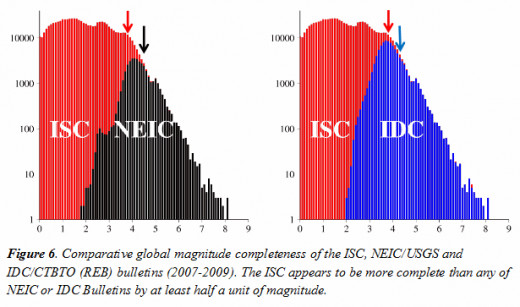The Most Complete Source for Earthquake Event Data (ISC)

In an earlier hub, where I reviewed earthquake activity for 2012, I revealed how it was a normal year if you relied on data from the United States Geological Survey (USGS), but was above average if you considered things based on the records kept by the International Seismological Centre (ISC) in the United Kingdom. In this hub I will detail more about this later agency and the differences between their data and the USGS/NEID.
One big difference is that the USGS is funded by government money while ISC is mostly funded by groups or individuals that are independent of the government. Their main concern is to be complete and precise and to take whatever time is necessary to achieve that purpose. As a result, they are a bit behind in reviewing their data. Lately, they have stated that they are up-to-date through November 2010. A look at the data coming from their online database however seems to show that it is more like through 2008 (for earthquakes of 7.5 magnitude or greater after that showed most of 2009 available but apparently not with the data reviewed thoroughly).
They have been the leader in an international project who's aim was to develop a comprehensive database of earthquakes from 1900-2009. Recently completed but not presently available to the general public, it is said to be complete for 7.5 magnitude or greater events (lesser events were mostly unavailable for the early decades). The project was funded by the Global Earthquake risk Model (GEM) Foundation.
One thing that ISC is proud to state, as was done in their director's annual report for 2011, they increased the size of their database by 24% in just one year and, as a result, their "...ISC Bulletin is more complete by at least half a unit of magnitude than the bulletins of either the NEIC/USGS or the IDC/CTBTO."

This later fact is well demonstrated when one compares the average number of earthquakes (for the period 1990-2009.99) given by NEIC and ISC in different magnitude ranges. In other words, one can clearly see a similarity in the numbers given by NEIC for 6.2-6.6 magnitude events (1314) and ISC for 6.7-7.1 magnitude events (1324). For earthquakes from 5.7 to 7.9 magnitude, ISC averages 3.2Xs more quakes than that given by NEIC. As seen in the graph at the top of this hub, if one divides the ISC data by three one gets nearly the same curve as shown by the NEIC data, so the two sets are pretty much proportional.

With the exception of their including some quakes without depth estimates or at times magnitude estimates (both removed from my tabulated results), their accuracy is superb, rivaling the NEIC data for epicenter coordinate accuracy. The NEIC restricts their data to quakes of 4.5 magnitude and above and has other qualifiers that limit their numbers whereas the ISC data has fewer factors to hamper a clearer and bigger picture of world seismicity. As a result, many seismologists from around the globe (not so much from the United States however) visit them each year to utilize their records to gain the greatest insights into their specialized interests.
Until I gain access to the new Reference Global Seismic Catalogue for 1900-2009, I have in the mean time utilized the ISC Bulletins to compare seismicity from 1968-2008 to that of sunspot activity. The results are shown below. I suspect that the two lesser spikes near the earlier solar minimums would be larger with more complete data which I hope to attain from the new, comprehensive database that was funded by GEM.
A few hours after writing the above paragraph I discovered a web page at the GEM's Global Quake Model web site that gives more details regarding what they are now calling the "ISC-GEM Global Instrumental Earthquake Catalogue. One especially welcome bit of news is that it should become available for public use sometime in January 2013!
Addendum: Here is a link to the download page for the new catalogue: http://www.isc.ac.uk/iscgem/download.php
This catalogue covers the years 1910-2009 for earthquakes of 7.5 magnitude and higher, 1918-2009 for earthquakes of 6.25 magnitude and higher, and 1960-2009 for earthquakes of 5.5 magnitude and higher.
It also includes such useful information as the uncertainty of recorded values like magnitude. Some of the most uncertain data is not in the main catalogue, but in a separate appendix file.


© 2013 Joseph Ritrovato








